Earth's Moon
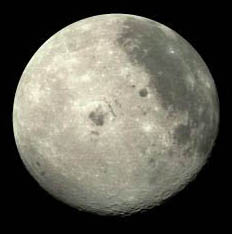 NASA Image |
This is a color composite image of the Moon taken by the Galileo Orbiter on December 9, 1990 at a range of about 350,000 miles. The color composite image made use of monochrome images taken through violet, red, and near-infrared filters. The concentric, circular Orientale basin, 600 miles across, is near the center; the near side is to the right, the far side to the left. At the upper right is the large, dark Oceanus Procellarum; below it is the smaller Mare Humorum. These, like the small dark Mare Orientale in the center of the basin, formed over 3 billion years ago as basaltic lava flows. At the lower left, among the southern cratered highlands of the far side, is the South-Pole-Aitken basin, similar to Orientale but twice as great in diameter and much older and more degraded by cratering and weathering. The cratered highlands of the near and far sides and the Maria are covered with scattered bright, young ray craters. (from the original NASA caption released with the image.) |
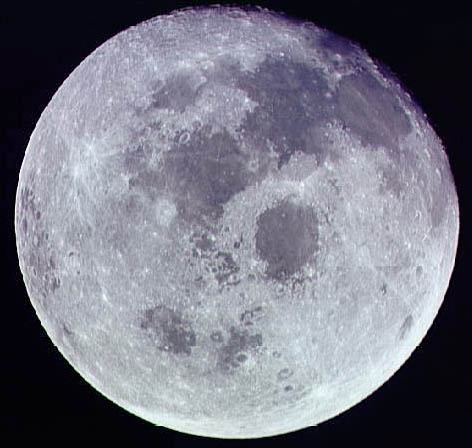
NASA Image
This full moon view was taken from the Apollo 11 spacecraft on its journey homeward on July 21, 1969. It was taken from a distance of about 10,000 nautical miles from the Moon.
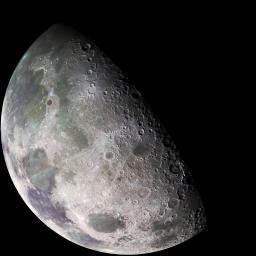 | 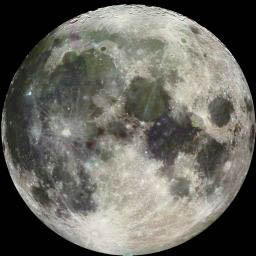 |
The image at left above is a North polar mosaic image of the Moon made by the Galileo Orbiter on Dec 7, 1992. The left part of this north pole view is visible from Earth. The image was assembled from 18 images taken by Galileo's imaging system through a green filter. The left part of this picture shows the dark, lava-filled Mare Imbrium (upper left); Mare Serenitatis (middle left), Mare Tranquillitatis (lower left), and Mare Crisium, the dark circular feature toward the bottom of the mosaic. Also visible in this view are the dark lava plains of the Marginis and Smythii Basins at the lower right. The Humboldtianum Basin, a 650-kilometer (400-mile) impact structure partly filled with dark volcanic deposits, is seen at the center of the image. The Moon's north pole is located just inside the shadow zone, about a third of the way from the top left of the illuminated region.
The full moon view above right was taken by Galileo on the same day. The distinct bright ray crater at the bottom of the image is the Tycho impact basin. The dark areas are lava rock filled impact basins: Oceanus Procellarum (on the left), Mare Imbrium (center left), Mare Serenitatis and Mare Tranquillitatis (center), and Mare Crisium (near the right edge). This picture contains images through the Violet, 756 nm (red) , 968 nm (infrared) filters. The color is 'enhanced' in the sense that the CCD camera is sensitive to near infrared wavelengths of light beyond human vision. These descriptions are excerpted from the original NASA captions.
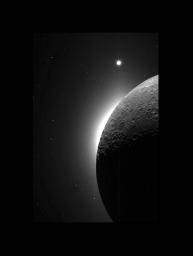 NASA Image |
Clementine Observes the Moon, Solar Corona, and Venus In 1994, during its flight, the Clementine spacecraft returned images of the Moon. In addition to the geologic mapping cameras, the Clementine spacecraft also carried two Star Tracker cameras for navigation. These lightweight (0.3 kg) cameras kept the spacecraft on track by constantly observing the positions of stars, reminiscent of the age- old seafaring tradition of sextant/star navigation. These navigation cameras were also to take some spectacular wide angle images of the Moon. In this picture the Moon is seen illuminated solely by light reflected from the Earth-- Earthshine! The bright glow on the lunar horizon is caused by light from the solar corona; the sun is just behind the lunar limb. Caught in this image is the planet Venus at the top of the frame. |
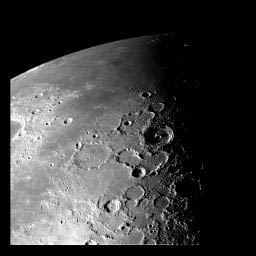 NASA Image |
This view of the north polar region of the Moon was obtained by Galileo's camera during the spacecraft's flyby of the Earth- Moon system on December 7 and 8, 1992. The north pole is to the lower right of the image. The view in the upper left is toward the horizon across the volcanic lava plains of Mare Imbrium. The prominent crater with the central peak is Pythagoras, an impact crater some 130 kilometers (80 miles) in diameter. The image was taken at a distance of 121,000 kilometers (75,000 miles) from the Moon through the violet filter of Galileo's imaging system. According to team scientists, the viewing geometry provided by the spacecraft's pass over the north pole and the low sun-angle illumination provide a unique opportunity to assess the geologic relationships among the smooth plains, cratered terrain and impact ejecta deposits in this region of the Moon (excerpted from the original NASA caption). |
Moon Concepts
Solar System Illustration
Solar System Concepts
| HyperPhysics********** Astrophysics | R Nave |